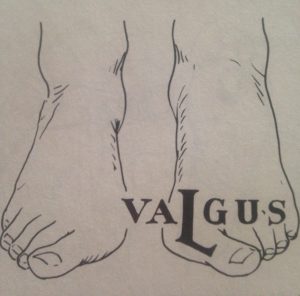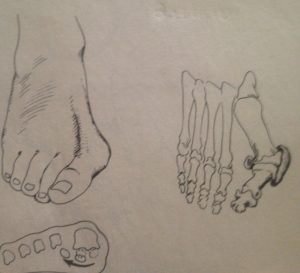Bunions (Hallux Abducto Valgus) – Not just for your granny!
You will be surprised to learn many people in there 20s and 30s have the infliction of “Ugly” toes or “deformed feet” as one of my friends call hers. In truth there are a partial dislocation of the big toe, as a result of improper biomechanics (how you use your body), use of shoes, or an injury the base of big toe moves medially (towards midline) and the top of the toe moves laterally (away from midline) in its joint, and subsequently a bursa develops (which may occasionally become red and inflamed) bony deposits are laid down to compensate for this and the deformity begins. In a lot of cases the big toe may deviate so much that it overlaps the 2nd toe like crossing one knee over another (which by the way you should also avoid as it creates structural imbalances).

Figure 1: Hallux Valgus
Researching for this blog I found an article highlighting the numerous celebrities, Amal Cooney, Catherine Zeta Jones, Imran Khan, Paris Hilton, Jennifer Lopez, Katie Holmes, and Naomi Campbell that are afflicted with this condition, under my search for Posh Spices Bunions, which I was shocked to see the biggest bunions I had ever seen one day watching her on an entertainment show. Yet I suppose it explains why she does not smile her bunions must have been excruciating. I’ve taking excerpts from the article from daily mail (http://www.dailymail.co.uk/tvshowbiz/article-3256914/Amal-bunion-brigade-Mrs-Clooney-s-not-star-tootsie-trouble-cure-bugbear.html#ixzz4B6zxZJCS) and shared here:

Figure 3: Diagram of Hallux valgus
‘First of all the synovial fluid becomes inflamed, and that’s why you get the initial red lump on the side of your foot,’ says Dr Khan.
‘Next the muscles and ligaments running up and down the big toe, which work to keep the toe straight, start to pull the joint away from the inside of the foot outwards.
‘As the joint becomes increasingly traumatised, and having lost the cushioning of the fluid layer, arthritis begins to form as bones rub against each other.’
The final stage, which is rare, is where the joint detaches altogether. ‘This is known as a windswept bunion,’ says Emma Supple.
According to Dr. Khan ‘It takes six weeks for bone to heal,’ she says. ‘You’ll spend two weeks in a surgical boot and the next four weeks pottering around in an oversized trainer — your foot is still swollen and bandaged. After three months you ought to be back in normal shoes. Plus can take up to 3-4 months before you can drive again.
‘That means whatever feels comfortable (and with your surgeon’s advice). If you’re able to wear stilettos again, then do. It’s unlikely that the bunions will come back — only very occasionally is this a complication.’
‘A podiatrist will examine the joint and get an idea of how low your arches may be,’ says Dr Khan. ‘They may suggest exercises, over-the-counter remedies such as gels, bunions pads, anti-inflammatory medication or splints to hold the toe in place.’
Anyone with the slightest indication of bunions should try the following exercises, recommended by Dr Khan.
- Sit with your feet out in front of you with a rubber band held between your two big toes. Pull feet away from each other so toes are straight. Do for two minutes twice a day.
- Stand on tissue paper and gather it up with your big toe. This exercises all the muscles in the foot and helps to redevelop the muscles in the arch of the foot.
- Stand facing a wall. Rise onto your tiptoes and hold for two minutes. This stretch works the deep muscle in the back of the leg, which runs all the way from behind the knee to the ball of the foot’s and helps to keep the toe supple.
In the UK in 2013 there were 3,781 recorded hospital admissions for bunion surgery for men and a staggering 29, 258 admissions for women. According to the NHS Statistics surgery improves 85% of symptoms in cases. I’m surprised at this statistic as in nearly 20 years of clinical experience I have yet to see one successful long lasting bunion surgery. Yes I’ve seen short-term reduction of symptoms yet in all cases the bunions had returned and presented to Kincora Therapy Centre for help. If anyone reading this has or had successful bunion surgery that has long lasting results please contact me I’d love to hear from you. In August 2014 I had the pleasure of meeting socially an American orthopedic surgeon and asked him “Tell me honestly does bunion surgery work in the long term?” “No, only short term solution the bunions grow back”. My reasoning for this is, as I believe bunions to be a biomechanical dysfunction the only long-term solution is changing biomechanics. Anecdotally most people who present for treatment to me also have low back in particular sacroiliac (SI) dysfunction. A holistic approach to helping bunions is to rebalance body, change biomechanics breakdown the body calcification over time. There is no instant cure just a little bit of self care and making changes structurally with the aid of treatment initially once a week for four week and then follow on for once a month for three to four months for diligent clients who do their home care daily. For more advanced deformities the timeline may be longer.
What’s involved with treatment? Initially some deep tissue massage around the feet and big toe in particular focusing on breaking down the body build up. Then follow The Bowen Technique protocols for bunion care, which involved daily use of an ointment from the ECBS (European College of Bowen Studies) that we stock at Kincora Therapy and homecare advice. Subsequent programs can include more exercises to prevent reoccurrence on dysfunction such as postural exercises and activation of postural muscles. I also highly recommend the use of toe separator socks whilst walking around at home, shoes like Vibram’s, which are like a glove and in the past people have had great success using MBT to help retrain their muscles and arches.
Call Kincora Therapy Centre now and talk to me Orla Foley about taking the next step in the right direction and helping relieve foot pain and normalize your feet.
Reference:
Physical Examination of the Spine & Extremities by Stanley Hoppenfeld

